The Flintstones: Surprise at Dinosaur Peak (NES Review)
May 26, 2024 4 Comments
 The Flintstones: Surprise at Dinosaur Peak
The Flintstones: Surprise at Dinosaur Peak
aka The Flintstones II
Platform: Nintendo Entertainment System
Released October, 1993
Developed by Taito
NEVER BEEN RE-RELEASED

Barney was always the real star, anyway.
Flintstones: Surprise at Dinosaur Peak is one of the three games in a trilogy of Taito NES games, along with Little Samson and Power Blade 2, that are worth a buttload of money. All recent copies listed on eBay sold for around $1,300. It’s one of the reasons why I can’t help but wonder if Taito is leaving a lot of money on the table by not putting out a collection of their Flintstones games. At first, I thought maybe they would be too generic, but then I played Surprise at Dinosaur Peak. It retains the engine from the previous game, Rescue of Dino & Hoppy. Fred’s sprite and various poses are virtually identical, as is his club attack. So, you can imagine my surprise that everything wrong with the first game has been cleaned-up here. Collision detection is improved enough that your club doesn’t clip through enemies, and it now feels like it has real world weight behind it. And, they even added a reason to charge up your club, as a fully-powered strike now creates a rumble that shakes the entire screen. As a result, the combat is very satisfying in Dinosaur Peak. It’s one of many elements that makes this not only the superior NES Flintstones game, but one of the most underrated titles on the entire platform.

Sports are back, only this time there’s no superpowers to be won. You really are just getting 1ups this time, I think. There’s only two events, with hockey going first and basketball returning for the second. I literally couldn’t believe they brought back basketball, almost identically as it was before. Except, this time you can do a running jump shot. If you time it right, it almost looks like a dunk. Oh, and this time around, each game is divided into two 30 second halves with Fred going first and Barney second. These are terrible, and since there’s a pause every time a score happens, they take a LOT longer than 60 seconds. If Dinosaur Peak gets a re-release, I sort of hope they cut these.
The biggest change is the addition of Barney. They couldn’t have implemented this better, as pressing select instantly swaps Fred and Barney. No special effects. No puff of smoke. No delay at all. In fact, there’s a couple moments built around this. Fred’s ability to grab most cliffs and pull himself up returns for the sequel, a maneuver his neighbor can’t perform. Instead, Barney can hang from wires or poles, then pull himself up and stand on them for a brief moment. He can even jump once he pulls himself up. Fred can’t do any of this, and there’s moments in Dinosaur Peak where you have to pull yourself up a wire with Barney, then jump up and swap to Fred mid-air in order to grab a cliff. It’s actually a lot trickier than it sounds to pull-off, which is why I’m thankful that type of design doesn’t show up until the end of the game. I should also note that the final sequence before the last boss requires some of the most precision movement I’ve seen, so you’ll want to practice. Thankfully, this go around the gameplay is smooth and the controls are damn near perfect. If there was a flaw in the last game, chances are it’s corrected for Surprise at Dinosaur Peak.

There’s even a brief shmup sequence that takes you to the final couple levels. A lesser game would have leaned too hard into this, but the Flintstones II’s shmup stage is over really quick, making it an enjoyable distraction.
Most of my complaints are really minor ones. Barney’s slingshot weapon is nowhere near as fun as Fred’s club, nor is there really any point where it feels like it’s necessary to use. Dinosaur Peak does a remarkably good job of mixing the platforming elements equally between Fred moments and Barney moments, but that didn’t carry over to the combat or enemies. Admittedly, I was fine with that since the club is so much more satisfying to use anyway. While the level design in general is consistently good, it never reaches the heights of true greatness. As much as I enjoyed Flintstones II, it never once managed to produce a single moment that made me sit up and go “wow!” It’s a game stuck in cruise control, and perhaps the best thing I can say about it is that it’s that rare game where the cruise control doesn’t drive it right off a cliff. That’s a minor miracle itself, because the bosses are very generic and the set pieces are unmemorable, except for the aforementioned shmup portion that’s really a glorified mini-game. Really, the most remarkable thing about Flintstones is that it proves the previous Flintstones had potential to be one of the best games on the NES, only the lack of polish wrecked its chances. This Flintstones realizes the potential and becomes one of the best platformers on a console defined by platform games.
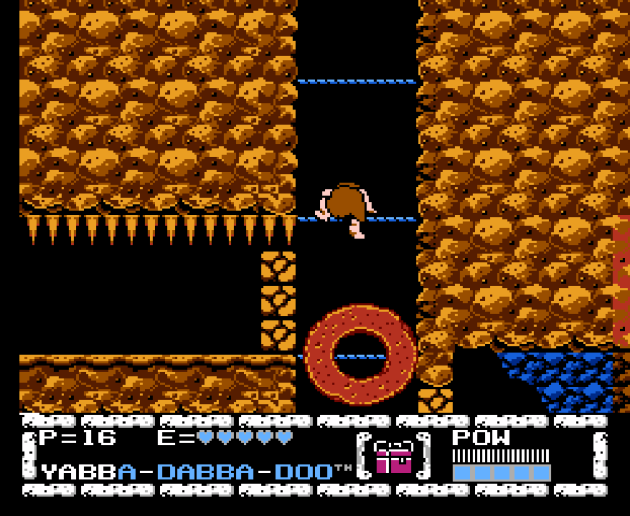
This donut is actually a relentless chaser and an instakill nightmare. Dinosaur Peak made being chased by a killer tire a thing before the 2010 horror classic Rubber made people afraid to get their tires changed.
Easily my #1 complaint is the sudden extreme difficulty spike that happens right before the final boss. After nine stages of relatively breezy platforming hijinks, the game introduces a malevolent tire that relentlessly chases you through a series of narrow corridors. There’s spikes everywhere, and while they don’t instakill you, your damage animation will take long enough that the tire, an instakill element, will certainly catch you. It’s not a short segment, either. It goes quite a long time, culminating with an astonishingly brutal final stretch. In it, you have to use Barney to climb up a shaft of tightropes, THEN switch to Fred to smash rocks in your way THEN switch back to Barney to climb the ropes again. The last boss in the next room is a cakewalk compared to this crap. It’s one of the most frustrating and difficult precision movement sections I’ve played recently. Up to this point, I think Flintstones II was right up there with Wacky Races in the “excellent game for children under 10” category, but that final area makes me second guess that, as it doesn’t allow any room for error. I think the average child will probably need a lot of help getting through it. I had built up 16 lives by this point, and hell, I’m pretty okay at this gaming thing. I ended up burning through all 16 lives and ultimately ended up reloading a save state. I literally couldn’t believe how overboard they went with this! You can almost hear the developers say “let’s see the little bastards get through this!”
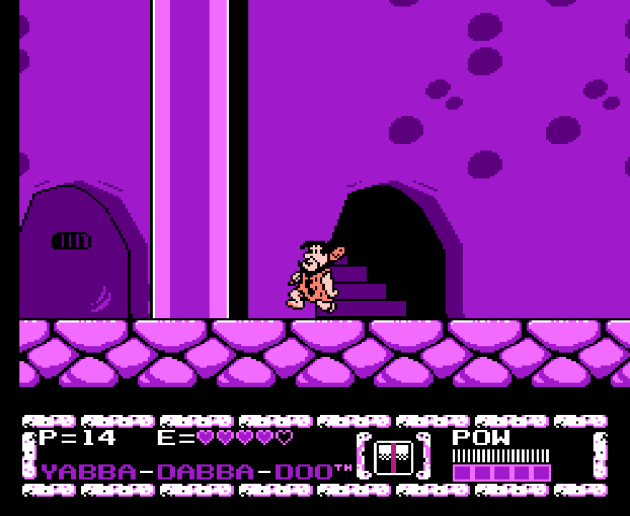
Actually, the Haunted House before this was a tricky one too. In it, you have to hit switches that briefly open doors, then sprint to them while not stopping for even a moment to do battle with ghosts that can be stunned but not killed. A few sections in this stage took me multiple attempts to finish. BUT, I don’t think a player is likely to die on that level. That wheel gauntlet at the end, on the other hand, is so cruelly brutal. I don’t understand what they were thinking. Perhaps this is one of those cases of “rental proofing” that I’ve heard about, where difficulty is ramped up in order to assure children can’t beat a game in a single weekend rental. Well, except for the fact that they didn’t produce many copies.
Even with that wheel section, I would call Flintstones: Surprise at Dinosaur Peak one of the all-time most underrated NES games. I’m now officially operating under the assumption that the post-Super Nintendo era of the NES was secretly a second golden age for the console. And instead of continuing this Hanna-Barbera marathon, I’m now much more interested in exploring this. What’s most heartbreaking of all is Flintstones II is so rare that it carries that wallet-busting $1,000+ value. That tells me that NES fans in 1993-94 likely never got to play it. Sure, anyone can use an emulator these days, but that doesn’t help an NES owning child in the mid-to-late 90s, does it? Dinosaur Peak deserved to be one of the titles that ushered the NES officially into gaming’s past. A wonderful title to remind everyone why the Nintendo Entertainment System was the savior of console gaming. It’s really good, and as a member of the NES’ most popular genre, it should have been celebrated as one of the final standard bearers of arguably the greatest gaming platform of all-time. That Flintstones: Dinosaur Peak is instead famous only for its holy grail rarity is a bonafide gaming tragedy. Hey Taito, it’s time for a compilation. Here’s your anchor game.
Verdict: YES!
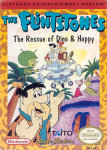 The Flintstones: The Rescue of Dino & Hoppy
The Flintstones: The Rescue of Dino & Hoppy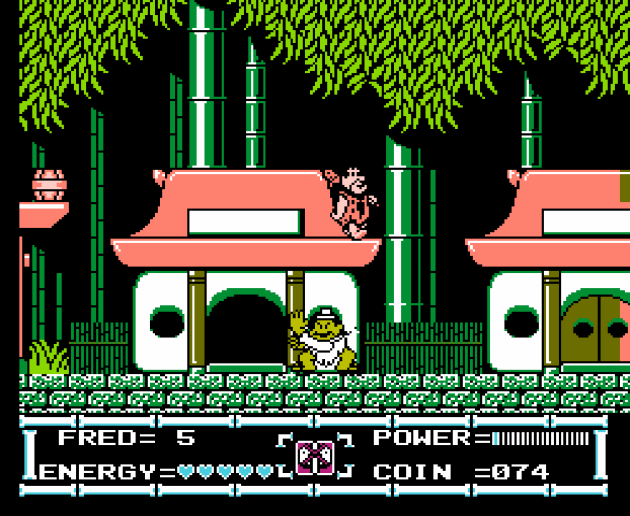
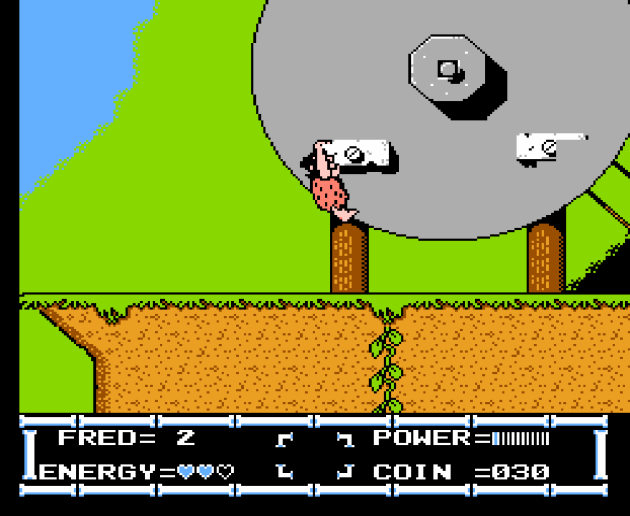
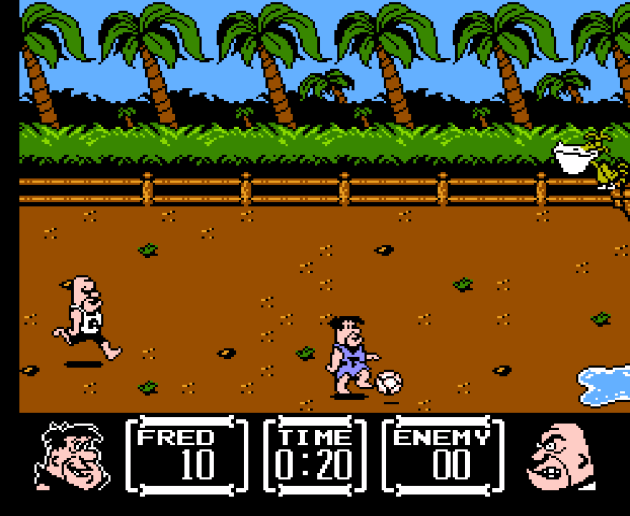

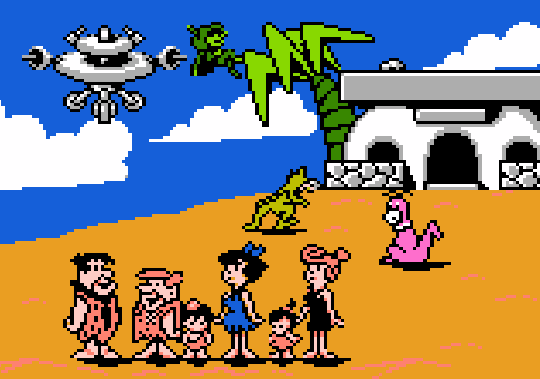

You must be logged in to post a comment.